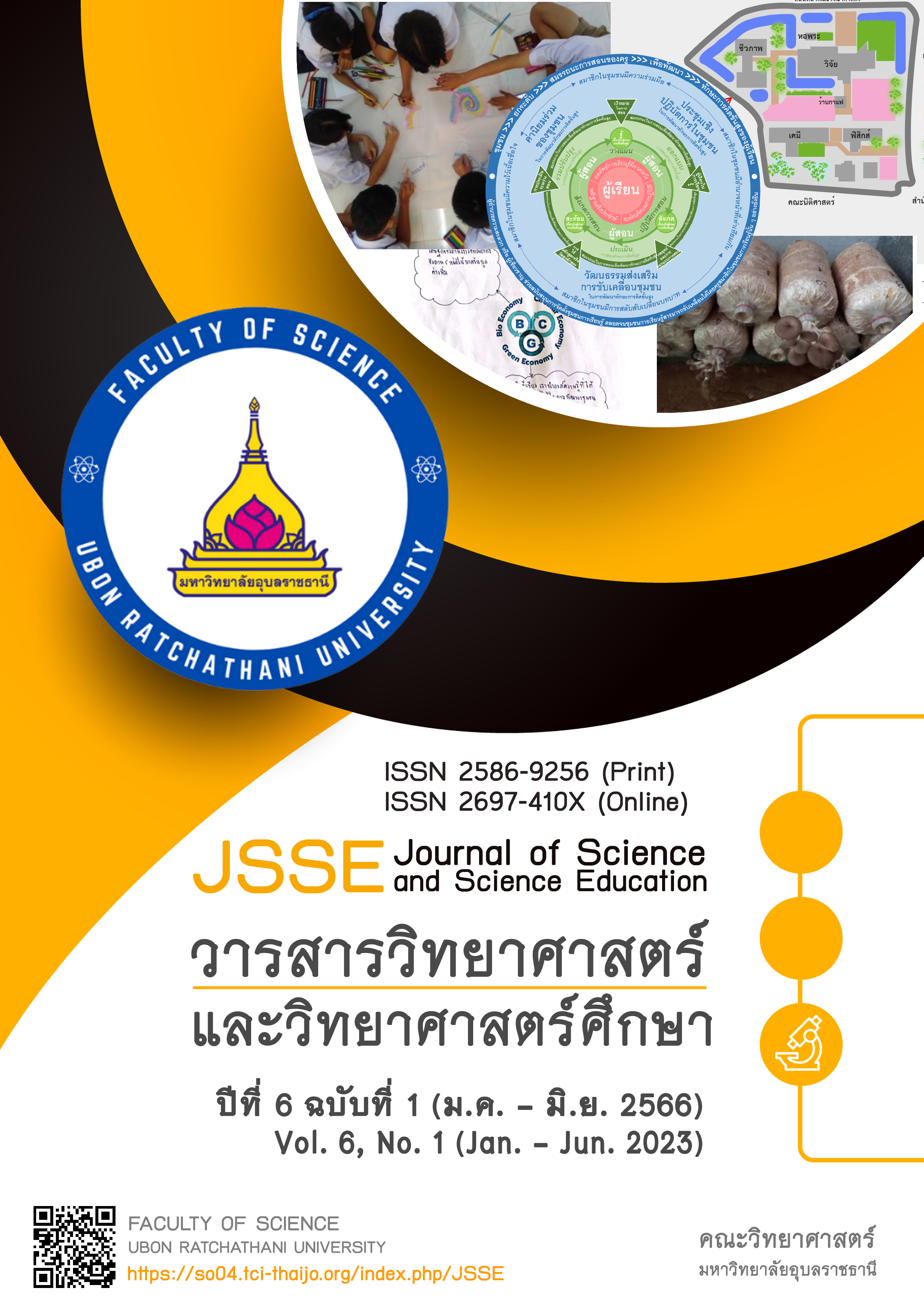การไม่มีของผลเฉลยจำนวนเต็มที่ไม่เป็นลบของสมการไดโอแฟนไทน์ a^x+b^y=z^2
Main Article Content
บทคัดย่อ
ในงานวิจัยนี้ ผู้วิจัยได้แสดงว่า ถ้า และ
เป็นจำนวนเต็มบวก และมีจำนวนเฉพาะ
โดยที่
โดยที่
ซึ่งทำให้
และ
แล้ว สมการไดโอแฟนไทน์
ไม่มีผลเฉลยที่เป็นจำนวนเต็มที่ไม่เป็นลบ
Article Details

อนุญาตภายใต้เงื่อนไข Creative Commons Attribution-NonCommercial-NoDerivatives 4.0 International License.
วารสารวิทยาศาสตร์และวิทยาศาสตร์ศึกษา (JSSE) เป็นผู้ถือลิสิทธิ์บทความทุกบทความที่เผยแพร่ใน JSSE นี้ ทั้งนี้ ผู้เขียนจะต้องส่งแบบโอนลิขสิทธิ์บทความฉบับที่มีรายมือชื่อของผู้เขียนหลักหรือผู้ที่ได้รับมอบอำนาจแทนผู้เขียนทุกนให้กับ JSSE ก่อนที่บทความจะมีการเผยแพร่ผ่านเว็บไซต์ของวารสาร
แบบโอนลิขสิทธิ์บทความ (Copyright Transfer Form)
ทางวารสาร JSSE ได้กำหนดให้มีการกรอกแบบโอนลิขสิทธิ์บทความให้ครบถ้วนและส่งมายังกองบรรณาธิการในข้อมูลเสริม (supplementary data) พร้อมกับนิพนธ์ต้นฉบับ (manuscript) ที่ส่งมาขอรับการตีพิมพ์ ทั้งนี้ ผู้เขียนหลัก (corresponding authors) หรือผู้รับมอบอำนาจ (ในฐานะตัวแทนของผู้เขียนทุกคน) สามารถดำเนินการโอนลิขสิทธิ์บทความแทนผู้เขียนทั้งหมดได้ ซึ่งสามารถอัพโหลดไฟล์บทความต้นฉบับ (Manuscript) และไฟล์แบบโอนลิขสิทธิ์บทความ (Copyright Transfer Form) ในเมนู “Upload Submission” ดังนี้
1. อัพโหลดไฟล์บทความต้นฉบับ (Manuscript) ในเมนูย่อย Article Component > Article Text
2. อัพโหลดไฟล์แบบโอนลิขสิทธิ์บทความ (Copyright Transfer Form) ในเมนูย่อย Article Component > Other
ดาวน์โหลด ไฟล์แบบโอนลิขสิทธิ์บทความ (Copyright Transfer Form)
เอกสารอ้างอิง
Acu, D. (2007). On a Diophantine equation. General Mathematics, 15(4), 145-148.
Aggarwal, S. and Kumar, S. (2021a). On the exponential Diophantine equation (19^2m )+(6γ+1)^n=ρ^2.
International Journal of Research and Innovation in Applied Science, 6(3), 128 – 130.
Aggarwal, S. and Kumar, S. (2021b). On the exponential Diophantine equation (13^2m )+(6^(r+1)+1)^n=ρ^2.
International Journal of Latest Technology in Engineering, Management & Applied Science, 10(3), 1 – 3.
Aggarwal, S. and Kumar, S. (2021c). On the exponential Diophantine equation (13^2m )+(6r+1)^n=z^2.
Journal of Scientific Research, 13(3), 845-849. doi: 10.3329/jsr.v13i3.52611
Aggarwal, S. and Kumar, S. (2021d). On the exponential Diophantine equation (2^(2m+1)-1)+(6r+1)^n=
z^2. International Journal of Research and Innovation in Applied Science, 6(4), 49 – 51.
Aggarwal, S. and Sharma, N. (2020). On the non-linear Diophantine equation 379^x+397^y=z^2. Open Journal of Mathematical Sciences, 4(1), 397 – 399. doi: 10.30538/oms2020.0129
Asthana, S. and Singh, M.M. (2017). On the Diophantine equation 3^x+13^y=z^2. International Journal of Pure and Applied Mathematics, 114(2), 301 – 304. doi: 10.12732/ijpam.v.114i2.12
Burton, D. M. (2007). Elementary Number Theory, 6th ed., McGraw-Hill, Singapore.
Chotchaisthit, S. (2012). On the Diophantine equation 4^x+p^y=z^2 where p is a prime number. American Journal of Mathematics and Sciences, 1(1), 191 – 193.
Gupta, D. and Kumar, S. (2020). On the exponential Diophantine equationa^u+(a+5b)^v=c^2w. International Journal of Interdisciplinary Global Studies, 14(4), 233 – 236.
Kumar, S. and Aggarwal, S. (2021). On the exponential Diophantine equation 439^p+457^q=r^2. Journal of
Emerging Technologies and Innovative Research, 8(3), 2357 – 2361.
Kumar, A., Chaudhary, L. and Aggarwal, S. (2020). On the exponential Diophantine equation 601^p+619^q=r^2. International Journal of Interdisciplinary Global Studies, 14(4), 29 – 30.
Paisal, K. and Chayapham, P. (2021). On exponential Diophantine equation 17^x+83^y=z^2 and 29^x+71^y=z^2. Journal of Physics, 2070, 1 – 3. doi: 10.1088/1742-6596/2070/1/012015
Redmond, D. (1996). Number theory: an introduction, Marcel Dekker, Inc., New York.
Sroysang, B. (2014a). On two Diophantine equations 7^x+19^y=z^2 and7^x+91^y=z^2. International Journal of Pure and Applied Mathematics, 92(1), 113 – 116. doi: 10.12732/ijpam.v92i1.10
Sroysang, B. (2014b). On the Diophantine equation 7^x+31^y=z^2. International Journal of Pure and Applied Mathematics, 92(1), 109 – 112. doi: 10.12732/ijpam.v92i1.9
Suvarnamani, A., Singta, A. and Chotchaisthit, S. (2011). On two Diophantine equations 4^x+7^y=z^2 and 4^x+11^y=z^2. Science and Technology RMUTT Journal, 1(1), 25 - 28.


